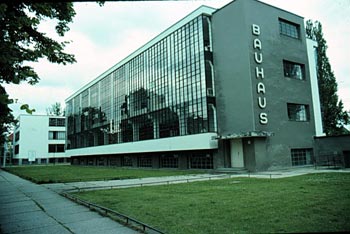
 |
||||
|
|
|
|
|
|

Bauhaus, Dessau
Walter Gropus, 1925-26 The International Style of architecture embraced new building methods, such as steel frame construction and reinforced concrete. Unlike the futurists they did not limit themselves in materials and allowed the use of methods of the past, such as load bearing masonry, where necessary. One of the defining factors of the style was the reliance of the intrinsic elegance of the materials instead of attempting to apply decorative coatings. The Bauhaus School in Germany played a role in creating and propagating the International Style of architecture. The primary driver behind the Bauhaus School was Walter Gropius, the founder of the school and the primary influence for the distinct style that the Bauhaus produced. He believed that the creation of a building was the highest of all forms of art because a building required the blending of the skills of the architect, artist, and craftsman into one. The breaking down of boundaries between fine art and craft was a central concept of the school producing a teaching program that focused on teaching a mastery of craft before more sophisticated artistic skills. The belief of mastery of craft was so strong for Gropius that the school at first did not have any classes in architecture, instead wishing to focus first on craft. 
Bauhaus, Dessau
Walter Gropus, 1925-26 Construction techniques and styles that surround us in today's buildings have their roots in the International Style. Like many of the major architectural movements, buildings from the style are still in use today and serve as a living example. |
| Resources |
|
Frampton, Kenneth. Modern Architecture - A Critical History. pp 248-262. New York: Thames and Hudson Inc, 1985. Gold, John R. The Experience of Modernism: Modern Architects and the Future City (1928-1953). pp 56. Great Britain: E & FN Spon, 1997. Gropius, Walter. World Perspectives Vol III - Scope of Total Architecture: A New Way of Life. Anshen, Rush Nanda. New York and Evanston: Harper & Row Publishers, 1955. Howe, Jeffery. "Walter Gropius". A Digital Archive of American Architecture. 1998. Boston College. 8 Dec 2004. http://www.bc.edu/bc_org/avp/cas/fnart/fa267/gropius.html |